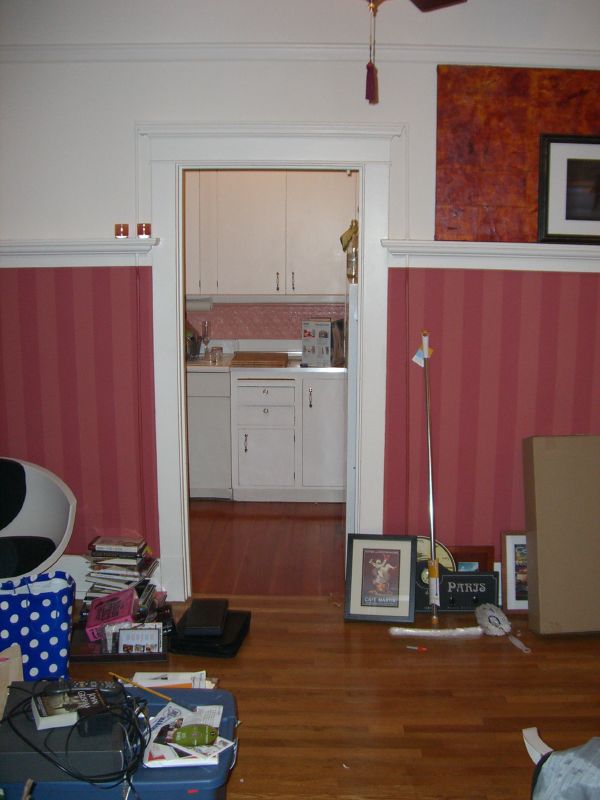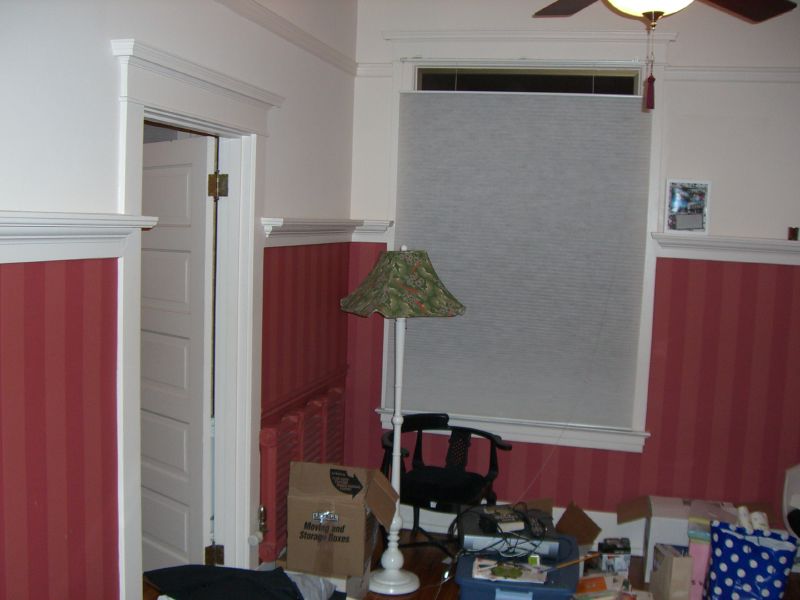Reader Question: Where do I begin?
Seattle decor8 reader, Erin H., wrote in recently and I wanted to share her letter with you since so many seem to express similiar feelings to me via email. Perhaps we can all band together and help eachother out.
"I'm a relatively new decor8 reader and I was particularly moved by your piece on design philosophy today. I recently took the plunge and seized a dream and an idea that seemed nearly impossible and incredibly far off, as I just became new homeowner in Seattle. I am now obsessed with nothing but paint colors, tile, furniture and design. But I love, love, love your blog - I appreciate the hints, links, tips, and ideas so much. I was inspired by your post today because as I stand in my (almost) entirely empty little 470 sq feet of space every night I have to fight the urge to heat n'eat. Its so strong. I'm a nester by nature and when I can see something decorated in my mind's eye I go into manic OCD mode to try and make it look that way in reality. Its a tough balance to strike when you move into something new and are basically starting from scratch. Though it doesn't match with your call for evolved rooms, I've attached some pics of my new place as its in the amoeba phase of its evolution. I'd be eternally grateful for your thoughts/comments/ideas. Its an interesting space in a 100 year old building with amazing crown moldings, wall paper, slightly odd dimensions, picture shelves throughout the living room. My first inclination has been to mesh a combination of modern pieces that take up little space and pieces that hearken back to the time period of the building. I am so excited to take my little corner of the world and truly make it my home. I aspire for it to be a place that invites others in, entices them to explore, ask questions, and want to know me. Thank for for the words of inspiration, the great photos, the helpful information and for putting your expertise out there for someone like me to stumble upon." - Erin T. (see photos to catch a glimpse of her space.)
CLEAR AWAY VISUAL CLUTTER AND BUILD A DESIGN BOOK
Well Erin, I'm sure the question on your mind is where to begin, huh? First of all, put everything you aren't using currently into those large plastic bins with labels detailing what's inside, and put them in the corner of a room you aren't using. Now it's time to give the space a thorough cleaning and decide what you will do with the walls. Will you repaint? Change the paper? etc. Then, work out your floor plan on paper and figure out your design style by turning to magazines for help. Clip your favorite rooms, items, pieces. After hours of clipping, if you didn't already know your design style, trust me, it will be clear to you now. You'll see a theme for sure. Examine each and every clipping, making notes along the way on the elements of the room that you are drawn towards. When I clip photos, I compile them into an notebook sectioned off by room, often using a glue stick to arrange them leaving plenty of white space for arrows and notes. It's VERY helpful to hit your local paint store and collect all the free paint chips that you can and match them to the current features in your home that cannot be changed - this way, you have the color chips to bring with you as you start shopping for furniture. Example: If your walls are blue and you love the color and do not plan on changing them, find a paint chip that matches the blue on your walls and keep that on you at all times so you can coordinate your findings with your wall color. There are so many tones and tints of colors, don't think you can 'remember' the blue on your walls well enough to go into a store and start matching things to the color in your mind. It seldom works unless you have the gift or are a trained color expert, like Tricia Guild for instance. Building a design portfolio, even if it's in a scrappy notebook, does worlds of good. Worlds. If you leave all your ideas trapped in your head and rely on memory to pull them out as you shop, it rarely happens. You often bring home items that make you feel less than inspired and that don't quite fit with what you already have. Trust me, once you're sucked into the vortex that is the furniture showroom, you lose all sense of personal goals and budget and are swept away into showy la-la land. When I shop with clients, I see this all the time. The moment they step into a furniture store and see all the beautiful arrangements, they start to second guess their own style and try to convince me that they really prefer this or that far better. In the middle of the store, I have to pep talk them into realizing that what they want is either out of scale, out of their budget, or will not fit the bones of the thier home (i.e. trying to fit an overly contemporary style into a cape cod home, for instance.), nor will it fit their lifestyle or personality. It's best to stay on target by carrying your design portfolio, which I equip my clients with for shopping trips so I can flip to the pages of images they they've clipped to get them back on track again. Reality check on aisle 12!
HUNT FOR KEY PIECES
Start with key pieces and then evolve your home from there. What rooms do you use in the home on a daily basis, and most often? These are the rooms you want to start working on. You need to eat, so you must carve out a space to eat. Find a table. I'm sure you have a computer, so you'll need a desk and chair. Perhaps you watch television, but not often. Maybe you can hold out on a sofa until you have the funds - first things first. You need a bed, dresser for holding clothes, table and chairs for eating, desk for the computer, etc. Next step is to invest in a sofa that you plan to keep around for awhile. Hunt, hunt, hunt! Don't settle or you'll be sorry. You can't paint a sofa and it's an ungodly amount of money to reupholster sofas these days (and slipcovers - well, I don't even want to go there) so when you purchase a sofa, purchase it considering that you'll own it for a very long time. It's different with desks and tables and such, you can slap on some fresh paint or change out the hardware whenever you tire of the current look. Sofas are a bit different. Sure, you can change the look by adding pillows and throws, but the sofa - comfort, lines, dimensions, features (sleeper, two seater, three seater, etc.), are not things you can change once you've purchased the piece.
ADD YOUR FUNCTIONAL FILLERS
After finding the basics - start looking for your functional fillers as I call them, things to fill the space but also that are ones you will actually use. An entryway table falls into this category for instance. Or maybe plant stands, additional seating for the living room areas, a bookcase, a buffet. Oh, and a good clock. Never underestimate the power of a good ticker. Clocks are so important in my own home, not only so I can avoid being late for appointments, but as a design element. And there are so many beautiful ones out there. Anyway, these functional fillers are your next step in decorating your space.
DESIGN AS YOU GO
Now we arrive at the most fulfilling of the 'steps', at least to me, the evolutionary process of designing your home as you go. This includes new tiles, updating your lighting, and even little things like art and glassware, etc. There is no expiration date, no 'purchase on or before', nothing that should drive you to complete your entire home and call it finished. Your home will never be finished. Never. You will always feel the need to edit, just as you do your own wardrobe, hair color, cut, even the car that you drive and your own DVD and music collections. It's normal and okay to get sick of pillows that you once were nuts over and now, can't stand the sight of.
As you shop for the 'jewelry' in your home, these non-essential adornments that we love but do not need to live comfortably (throw rugs, art, vases, pillows, throws, trinket boxes, new tile in the bath, etc.) continue to keep your goals in clear view. If you don't like a cluttered home, limit yourself to arranging only 3 items on your credenza for instance. Don't bring home every adorable thing you see, you may not have space and in these cases, we try to make space which leaves the home feeling weighed down. Editing the space is suggested, and I do this by making a personal pact with myself. Whatever I purchase, I must give away. Swapping is not only good for others and the environment, but it's good for the home so once you get your pad to this stage where everything in place, start swapping pieces as the years go by.
Of course, there are so many details to each of these steps that I could include, but I'll fill the entire page of this blog if I allow myself to keep typing. I think this gives you a good plan of attack for now, and please comment below with any questions and I'll see what I can do to further assist you and other decor8 readers, too!
Oh, and as you work out the above stages...
DO YOUR HOMEWORK
Apart from the slew of informative design blogs out there, Apartment Therapy being the leader in this area of DIY, may I suggest some design books? Some of these may help you as your begin your journey.
(images from erin)



